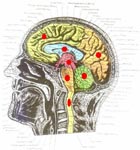Brain circuits used in sensation of touch identified

Washington, Oct 11 : A study has identified the brain circuits that facilitate spatial discrimination through touch.
With the usage of functional Magnetic Resonance Imaging (fMRI), the researchers found an increase neural activity in a network of frontoparietal regions of the brain when people engaged in fine tactile spatial discrimination
In the network, the levels of activity were predictive in two sub regions of the right posteromedial parietal cortex, the right posterior intraparietal sulcus (pIPS) and the right precuneus, of individual participants' tactile sensitivities.
To determine the areas of brain involved in identifying fine spatial details, the team questioned 22 volunteers.
The participants were asked to determine only by touch whether the central dot of three vertically arranged dots was offset to the left or to the right of the other two.
"Using their right index fingers, the subjects got to feel the dots for one second to determine in which direction the central dot was offset,” said Krish Sathian, MD, PhD, professor of neurology in Emory University School of Medicine.
"We also varied the amount the dot was offset from the other two, which allowed us to quantify people's sensitivity. In other words, we asked what is the minimal offset required to discriminate," he said.
In a branched out control task, the subjects were asked to determine the duration of the touch by three perfectly aligned dots.
During the temporal task, brain activity was contrasted with brain activity, during the spatial task.
After analysing the volunteers it was found that different brain regions showed more activity during either spatial or temporal processing.
"What is interesting is that we found the most relevant areas of the brain for spatial processing are on the right side, the same side of the body that was used to feel the stimuli. This is the opposite side to the one that might be expected," said Randall Stilla, research MRI technologist at Emory.
"We usually think of the left side of the brain as controlling the right side of the body, which is generally true. But more and more we are finding that the right side of the brain is particularly important in many types of sensory processing," Sathian said.
Through the understanding of the neural circuitry, sensory-substitution devices can be created, such as tactile maps for the visually impaired.
The study is published in The Journal of Neuroscience. (ANI)